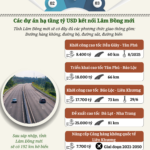Today (July 1st) marks the first day of operations for the newly merged provinces and cities, as they transition to a two-tier local government model. As a result of these mergers, Vietnam now has 34 provinces and cities, a significant decrease from the previous 64. With some of the new provinces being formed from the merger of two to three administrative units, there have been notable changes in their respective areas and populations.
The top five largest provinces in terms of area as of July 1, 2025, are Lam Dong, Gia Lai, Dak Lak, Nghe An, and Quang Ngai. Prior to the mergers, this list included Nghe An, Gia Lai, Son La, Dak Lak, and Thanh Hoa. Despite the changes, Nghe An remains among the top five largest provinces with an area of 16,487 square kilometers.

Lam Dong province boasts the largest area in Vietnam.
Lam Dong, the newly merged province of Lam Dong, Dak Nong, and Binh Thuan, now holds the title of Vietnam’s largest province with an impressive area of 24,233 square kilometers. This province is unique as the three original provinces belonged to different economic regions – the Central Highlands and the South Central Coast.
The merger of Gia Lai and Binh Dinh has resulted in the formation of a new province named Gia Lai, spanning over 21,576 square kilometers. Meanwhile, the combination of Dak Lak and Phu Yen has led to a province with an area exceeding 18,000 square kilometers, with its administrative center located in the current Dak Lak province.
The newly structured Quang Ngai province, a result of the merger between Quang Ngai and Kon Tum, now covers more than 14,800 square kilometers.
On the other hand, the five smallest provinces in terms of area as of July 1, 2025, are Hai Phong, Hung Yen, Bac Ninh, Ninh Binh, and Hanoi. Prior to the mergers, this list included Bac Ninh, Ha Nam, Hung Yen, Vinh Phuc, and Da Nang. However, Da Nang, now a centrally-controlled city, has expanded significantly after its merger with Quang Nam, boasting an area of over 11,859 square kilometers.

Hai Phong is renowned for its breathtaking tourist attractions and delectable cuisine – Image: Internet
Hai Phong, despite its merger with Hai Duong, retains its position as the smallest city in Vietnam with an area of 3,195 square kilometers. Prior to the merger, Hai Phong and Hai Duong had areas of over 1,500 and 1,600 square kilometers, respectively.
The former Hung Yen province, with an area of just 930 square kilometers, has now merged with Thai Binh, which had an area of nearly 1,600 square kilometers. The new Hung Yen province has an area of 2,515 square kilometers, making it the smallest province in the country. However, it boasts a high population density, with over 1,400 people per square kilometer, placing it among the provinces with the highest population densities in Vietnam.
The newly merged province of Bac Ninh and Bac Giang has a total natural area of 4,718.6 square kilometers. Similarly, the merger of Ha Nam, Ninh Binh, and Nam Dinh has resulted in a new Ninh Binh province with a total area of 3,942.5 square kilometers.
Hanoi, with a total area of 3,359.84 square kilometers, is also among the five smallest provinces and cities in Vietnam following the mergers.
A Rush of Highway Construction and Airport Expansion: How Billion-Dollar Infrastructure Projects Are Propelling the Country’s Largest Province Forward Post-Merger
The Lam Dong province is embarking on a transformative journey of expansion and connectivity. With the construction of a new highway, the province is unlocking its southern gateway, forging links with the Central Highlands, Southeast, and South-Central regions. This strategic move paves the way for a breakthrough in the development of the newly merged province, setting the stage for a thriving future.
“Construction Begins on Bao Loc – Lien Khuong Expressway, Reducing Travel Time Between Ho Chi Minh City and Dalat to Just 3 Hours”
The groundbreaking ceremony for the Bao Loc – Lien Khuong expressway project marks a momentous occasion. This new expressway will serve as a powerful catalyst, injecting new impetus into the key economic sectors of Lam Dong and its neighboring provinces. With this infrastructure development, travel time between Ho Chi Minh City and Dalat will be significantly reduced from a 6-hour journey to just 3 hours.
Investing Over $1.8 Billion in the Quy Nhon – Pleiku Expressway
The National Assembly has passed a resolution approving the investment policy for the Quy Nhon-Pleiku expressway project. This ambitious undertaking promises to revolutionize travel between these two vibrant cities, offering a seamless and efficient transportation experience. With construction soon to commence, this expressway marks a pivotal milestone in Vietnam’s infrastructure development, paving the way for enhanced connectivity and prosperity.





















